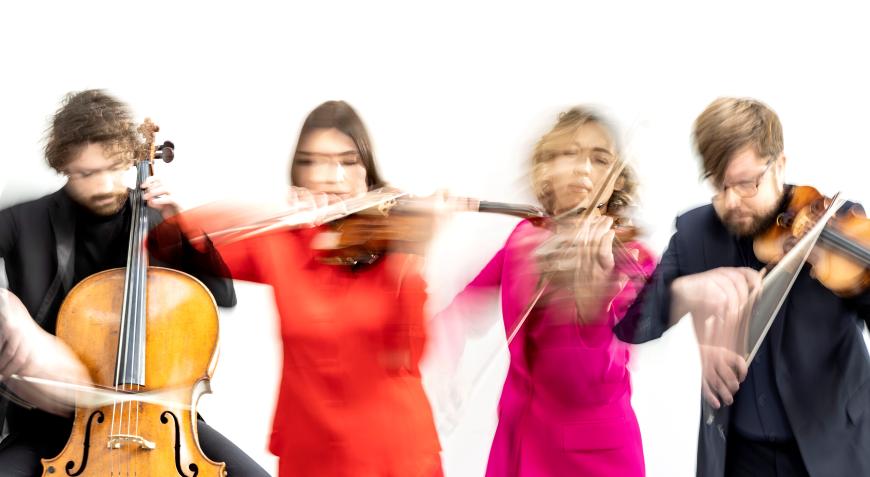
String quartets, like people, have their own personalities, developed as their members work together over a long period of time. You might hear a quartet called “elegant,” or “aristocratic,” or “genial.” If you were trying to characterize the Castalian String Quartet, formed in 2011 and currently in residence at Oxford University, you might settle on “intense.”
That was certainly the last and biggest impression the group made at Cal Performances on March 19 as its program closed with a superb account of Franz Schubert’s enormous String Quartet No. 15 in G Major, D. 887. Written in 1826, the quartet has much in common with other major works of the composer’s last years, such as the Cello Quintet, D. 956, and the Piano Sonatas in B-flat Major, D. 960, and A Major, D. 959.
Schubert composed the quartet on a grand scale, like those other pieces; a performance with all repeats taken runs about 45 minutes. The work’s tonality flutters between major and minor, and it can enchant you with its sweetness or lead you to look into a chilly abyss. The Castalian foregrounded the vast emotional range of the piece, not just with its phrasing but with its very sound. These players could thin out that sound for the chilly ecstasy of some of the first-movement themes or fatten the sound for fierce attacks in the last movement.

The group achieves this range of colors largely by lightening or broadening vibrato as appropriate. This was particularly evident with cellist Steffan Morris, who played with a gravelly, growly tone or with the greatest delicacy in his solos throughout the Schubert and elsewhere. The breathless last movement leaves you wondering whether Schubert will ever get back to a major key, which he finally does, rounding out the work with a sunny theme that’s surprisingly trivial compared with the overall weight and seriousness of the piece.
The players’ ability to lighten their tone gave the opening Haydn Quartet in D Major, Op. 20, No. 4, a historically informed flavor and transparency. This performance caught the abundant wit of the piece and also its depths, particularly in the beautiful variations of the slow movement. The Castalian leaned heavily into Haydn’s rhythmic tricks in the minuet, where he fools you into thinking a movement that’s written in three-quarter time is in a duple meter. The Quartet took the last movement at an astonishing speed.
Between the Haydn and Schubert came Kaija Saariaho’s second string quartet, Terra Memoria, a work commissioned by the Emerson Quartet and composed in 2006. First violinist Sini Simonen, herself a Finn, took up a microphone to briefly introduce the piece, calling Saariaho Finland’s most prominent living composer. Simonen discussed the composer’s connections to spectralism, her deep concern with the nature of sound, and her use of computers and electronics in composition. That said, Terra Memoria is an entirely acoustic work, one that achieves remarkable sonic effects solely through what string instruments can do.
It’s an intense work, about 15 or 20 minutes long, that reflects on the relationships the living continue to have with the dead. The dead do not change, but the feelings of the living might. The piece is in a single movement that nevertheless has clear demarcations and contrasts. Its opening seemingly emerges out of nothingness, so quietly that it’s not entirely clear where the boundary is between sound and no sound. Voices weave around each other in a counterpoint of sustained tones, hovering around a single tonal center. The tonal center shifts; all is calm.

A louder and more turbulent section follows, still rotating around a fixed center. Eventually, following some loud, sustained tones, a hushed section in harmonics sounds as if it’s coming from a great distance, suggesting things not quite heard. Perhaps ghosts are speaking to you, or perhaps it’s your synapses. The string sounds are tiny and crystalline. The quiet is again followed by turbulence, with harsh unisons and a veritable buzzing coming from the instruments. A quietly melancholy section follows, and the quartet fades out in calmness.
The Castalians performed Terra Memoria with the same intensity they brought to the Schubert and with complete technical and musical command over complex materials. They last played in the Bay Area about a year ago, and they can’t return soon enough for this listener or, apparently, for everyone in the audience, which gave them a well-deserved standing ovation at the close of the concert.




